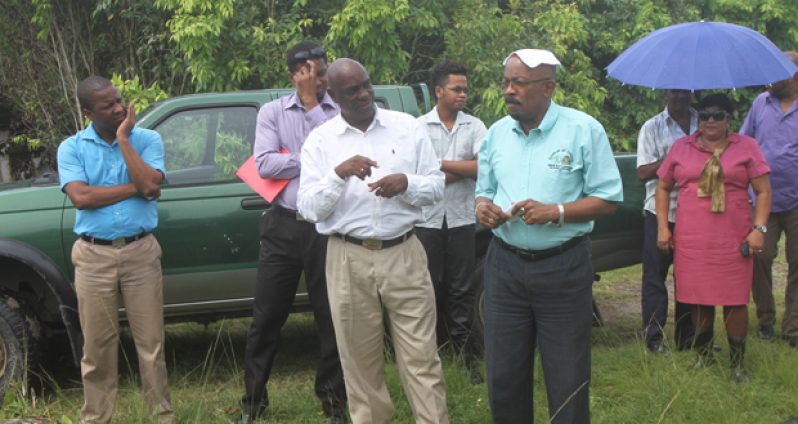OFFICIALS of the Ministry of Local Government and Regional Development (MLGRD) on Wednesday hosted members of the media in a tour of the current works being undertaken by the Georgetown Solid Waste Management Project (GSWMP).
Present were Minister Norman Whittaker of the LGRD Ministry, Project Coordinator of the GSWMP, Mr. Gordon Gilkes; Acting Town Clerk of the Georgetown Municipality, Ms. Carol Sooba; City Engineer Mr. Colvern Venture, and other LGRD Ministry and M&CC officials.
INTERNAL DRAINS

Minister Norman Whittaker questioned the Operator Harripersaud, an employee of the Contractor Ivor Allen, on the possibility of debris from the desilting of internal drains of the Le Repentir Cemetery washing back into the drains by heavy rainfall.
The Minister requested that the debris be removed as soon as possible to prevent that occurrence, which he said would double the work of the contractors and hamper the progress of the works being done.
Contractor Ivor Allen was awarded $5.828M as part of the first component of the Le Repentir Restoration Project. The Minister assured that the works would be completed by the end of September.
AFRICAN BEES

The Minister said that an area of concern for residents is the hives of bees in the cemetery. The Guyana Apicultural Society (GAS) is accordingly working along with the contractor to handle the problem of removing the bees. Apiculture is a technical term for bee-keeping.
GAS President Mr. Linden Stuart made clear that the African Bees, which are often extracted from the tombs, are captured and taken to the bee farms along the Soesdyke-Linden Highway.
Stuart noted that close to seven boxes of bees had already been removed from the Cemetery along St. Stephen Street. He added that the bees are usually agitated during the rainy season, and considering the heavy machinery being used in the area, the bees would be quite tense at this time, clearly outlining the need for the contractor and the apiculturists to work together to remove the bees.
Stuart and his team presented the startling reality that one tomb can house close to 80,000 African bees, with a Queen that will lay close to 30,000 eggs per day.
CEMETERY DEBUSHING
There is also need for de-bushing the area, and GSWMP Coordinator Gordon Gilkes noted that labour for the bebushing exercise would partly be drawn from the Prison Service, whose labourers would be provided with the necessary safety equipment for dealing with the current situation at the cemetery.
Minister Whittaker explained that the works would not be undertaken solely by the Prison Service, but other community groups would be contracted to work along with the contract holders, while the LGRD Ministry would employ a Clerk of Works to oversee effective discharge of the works.
Senior Superintendent Samuels of the Georgetown Prison Service explained that the LGRD Ministry is currently in talks with the Prison Service to acquire close to 20 prisoners to begin working on this clean-up project from Monday, “providing that they finalise the logistics in terms of payment and so forth.”
This vigorous and expansive project will focus on restoration of the cemetery in its entirety. The cemetery is bordered by Princes Street to the north, Sussex Street to the south, St. Stephen Street to the west, and Mandela Avenue to the east.
The internal drainage system of the cemetery is integral, since it flows directly into the Sussex Street Canal.
A later aspect of the project will see the roads in the cemetery being made accessible for commuting.
(By Derwayne Wills)



.jpg)











